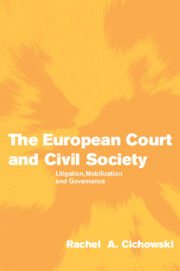Book contents
- Frontmatter
- Contents
- List of figures
- List of tables
- Acknowledgments
- 1 Introduction: institutions, organizations and actors
- 2 Overview of institutionalization in the European Union
- Part I Institutionalization through litigation
- Part II Institutionalization through mobilization
- 5 Women's rights activists: informal to formal organizing
- 6 Collective activism for the environment
- 7 Conclusion: litigation, mobilization and governance
- References
- Index
5 - Women's rights activists: informal to formal organizing
Published online by Cambridge University Press: 22 September 2009
- Frontmatter
- Contents
- List of figures
- List of tables
- Acknowledgments
- 1 Introduction: institutions, organizations and actors
- 2 Overview of institutionalization in the European Union
- Part I Institutionalization through litigation
- Part II Institutionalization through mobilization
- 5 Women's rights activists: informal to formal organizing
- 6 Collective activism for the environment
- 7 Conclusion: litigation, mobilization and governance
- References
- Index
Summary
“Europe, an opportunity for women; women, an opportunity for Europe.”
Transnational activists have become an integral part of European policy making. Public interest advocates were not direct participants in the making of the European Union (EU) in the 1950s and public interest policies were not on the agenda. As we have seen from the previous chapters, today this same supranational space possesses jurisdiction over an ever-expanding array of public policies. The EU possesses a growing net of rules governing national social provisions and environmental protection. In Chapters 3 and 4, I illustrated how this process of institutionalization could occur through litigation and how the rules over time have become more binding, precise and expanded in scope. Yet equally important to this policy evolution is the fact that today national executives are no longer alone in this space. Instead, public interests – as represented by non-governmental organizations (NGOs), legal consultancy firms and individual activists, to name just a few – are equally present in EU policy processes. As this litigation and legislative action provided new political opportunities for action, individuals and groups answered the call, shifting their mobilization to this newly forming supranational space.
The causes and effects of this transnational mobilization are the focus of this chapter and Chapter 6. In particular, I focus on how institutionalization can take place through mobilization. As argued in Chapter 2, we might expect this activism to follow a generalizable pattern.
- Type
- Chapter
- Information
- The European Court and Civil SocietyLitigation, Mobilization and Governance, pp. 171 - 206Publisher: Cambridge University PressPrint publication year: 2007

